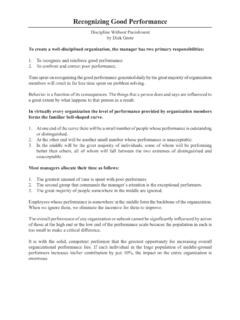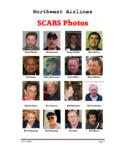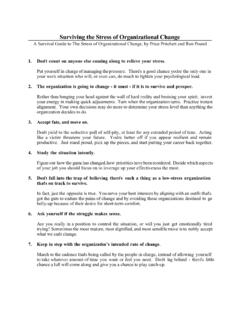Transcription of Location Numbering - Design - Warehouse Coach
1 Warehouse Coach Improving Warehouse performance 1 Location Numbering Design and implement By Don benson Yesterday I visited a small facility and was reminded that many Warehouse operations do not have a structured way to identify storage and pick locations . In that Warehouse , several of the staff were out sick that day and the remaining staff were spending a lot of time searching for the merchandise to fill orders. Relying on people s memory of where merchandise is located can work well only as long as the number of locations is small and the people that know where the merchandise is located come to work every day. The interesting part of this situation for me was that only a few days before I was visiting a sporting goods Warehouse where the merchandise was stored by vendor and the method was contributing to significant pick errors as the merchandise was packaged in boxes that were so similar as to be almost impossible to distinguish one SKU from another.
2 In both situations once we began to discuss Location Numbering I discovered again how difficult it can appear to develop a Numbering system and get it installed. There are many different Location Numbering systems, perhaps as many as the range of reasons and logic patterns that our creative minds can develop. And, while each of these systems works, if you do not have a Location Numbering system in your Warehouse , I recommend you take the initiative to begin the process of creating and installing one. This column will provide you with a set of proven Design guidelines/logic that we have used for Location Numbering in many facilities, and suggest some first steps to consider as you begin to change your processes to use the Location numbers in your picking, stocking, and inventory management.
3 First, you should base your Location Numbering on simple and consistent logic, logic that can make it easy for a new Warehouse employee to learn and for the seasoned employees to use when rushed or in a hurry. I recommend that your storage Location Numbering system mirror the system that city planners use outside the Warehouse to identify the street and house addresses in a typical city. Second, I recommend that your Location Numbering system contain numbers only and not include alphabetic characters. Some people like to see Location addresses include ABC s instead of 123 s, and perhaps using the first part of Warehouse Coach Improving Warehouse performance 2 the alphabet can work, but probably not beyond E, F or G. So if you feel strongly about using alphabetic characters, I suggest that they be used for elements of the Location with no more than 5-6 options, for example the levels in rack or shelving, and not the aisles.
4 One example to illustrate my recommendation not to use alphabetic characters is that we do not quickly remember whether F comes before or after G. So as we move from one Location to another, it takes more time than when moving from position 8 to position 9. Thirdly, Location Numbering should be as specific as possible, identifying each of the elements of each logical storage Location , , aisle, section or bay (between uprights in rack or shelving), shelf or level (starting at the floor level and ascending), and position on the level from left to right (on pallet rack that could be two or three pallet positions). One format for this Numbering appears below: XX XX X X Position on a Level, counting from left to right between uprights Level or shelf, counting from the floor within a section Section, the portion of the storage aid between uprights Aisle Aisle -- Each aisle should have an aisle number.
5 Consider using a separate sequence of aisle numbers for each logical work area in the Warehouse , , repack, pallet rack, floor stack, etc. In racked areas, assigning numbers to aisles instead of rack or shelving rows supports cross-aisle picking, which will increase productivity by reducing the total travel distance by directing the picker to select all of the materials required in that aisle as a part of a single trip through the aisle. Where there is a conveyor installed down the center of the aisle in an aisle, we can assign addresses to rack rows instead of aisles, if Warehouse Coach Improving Warehouse performance 3 your computer programmer finds it difficult to sequence picking documents using the odd-even section Location number elements described, below.
6 Generally we assign numbers to aisles ascending from 01, beginning at one side of the building and continuing toward the other. This method also supports the spatial orientation, so it is easy to remember that the higher numbers are toward one end of the building and the lower aisle numbers are toward the other end. For example 01-XX-X-X Section -- Select the conventional entry end of the aisles (typically this nearest to the receiving dock side of the building), and assign numbers to rack sections beginning with the number 01 to n with numbers ascending, odd numbered sections on the left side of the aisle and even numbered sections on the right side. A section is the area between the uprights. Some use the term bay to describe the same space.
7 For example, 01-01-X-X Level Assign an address from 1 to n to each level within each rack or shelving section, ascending from the floor as 1. Each level would be a shelf or pair of beams. For example, 01-01-1-X. Position -- Within each shelving or rack-section-level, assign numbers to each position, ascending from 1 to n , from left to right as you face the section. Traditionally, each Location is separated from the next with a divider, bin box, or a painted or tape line on the shelf deck and lip to help keep materials in their assigned Location . In pallet rack, typically there would be 2 positions on each level, numbered 1 and 2. For example 01-01-1-1. Special Use locations -- In rack used for the hand stack of small amounts of cases, the Location numbers on a shelf usually range up to 9.
8 In repack shelving or carton flow rack, Location numbers usually do not exceed 9. To accommodate small items in drawers, we have used 2 digits to describe the locations using a 9X9 grid locator, , row and column. In floor storage locations , we assign one Section Number to each pallet row facing the aisle, odd numbers on the left and even numbers on the right. Once you create set of guidelines that make sense, the next step is to use a plan drawing of your layout to verify that it works. I actually write the numbers on the layout and use it to explain it to others. Usually I include the staff, particularly pickers and stock people who typically enter the storage area Warehouse Coach Improving Warehouse performance 4 from the Receiving Dock and want to find a particular Location easily.
9 If the workers can understand your Numbering system and imagine that they can find their way around the Warehouse with those numbers, you are well on your way to an effective Location Numbering system. The last step is to print the Location numbers on label stock to put the addresses on the aisles, beams, shelves, etc. Several companies specialize in Location labeling solutions. Some will even print the numbers on the stock for you. I recommend that you consider using Yellow rather than White label stock for your labels. I have found that Black characters on Yellow paper seem to read more clearly in medium light areas on upper levels of rack or for all locations when my eyes are tired at the end of the day. You could also ask your IT person to help with this.
10 Perhaps you buy the stock and get him/her to print the labels for you. In this way that person becomes more familiar with what you are doing, your objectives, etc. Then later, when you ask that the numbers be integrated into the computer system so that you can get a Location sequenced pick document, etc., the staff will be more prepared to understand and help. In any case, once the numbers are there, there will be a growing interest in using them, from many different areas in the company. So check back in a few weeks and I will discuss some ways you can use the Location numbers to improve your productivity and quality performance. If you run into challenges in this project, please call or write to me at or call me at 1-503-296-7249. I am sure we can work out a Location Numbering solution that will work well for you and your company.




